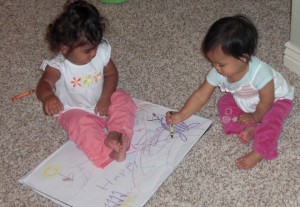Schedule
Sample Of Forehead Kisses Nanny Schedule & Responsibilities:
We enjoy and love been outdoors with children. We believe it’s very important for children to expand their imaginations. We love going to parks, zoos, playdates, nature walks, birthday parties, mommy & me music class & more
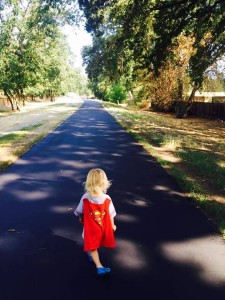
8:00am – 8:30am
Wake baby up and get him or her dressed

Breakfast Time/ Clean up baby dishes
Homemade baby food, Baby cereal, Breast Milk
Will there be times that my baby will need more milk than I have ready?
Yes, your baby will probably want more milk during growth spurts. The best way to increase your milk supply for a growth spurt is to breastfeed or pump more often.

9:00am – 10:00am
Story time, Playtime- 4-12 months BABY GAMES, Go to the park, play dates.

1* Basic Baby Sign Language-
• “food” — put your finger tips to your lips
• “all gone” — move your hand, palm up, backward and forward
• “scared” — tap your chest again and again
• “hot” — put your hand out and withdraw it quickly
Baby Sign Language
Babies can use sign language to communicate before they speak v ocally. Using their gross motor skills they can communicate general terms using sign language to convey how they feel or what they want.
ocally. Using their gross motor skills they can communicate general terms using sign language to convey how they feel or what they want.
Why are thousands of hearing parents signing with their hearing babies?
• talk sooner and have larger vocabularies
• have stronger parent/child bonds
• have less frustration, crying and tantrums
• show more interest in books
• engage in more sophisticated play
• have increased IQ scores
Signing also increases baby’s self-esteem and gives parents a window into their child’s mind and personality.
Tummy Time
My daughter is 4 months old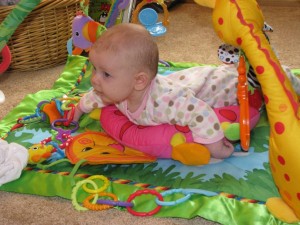 and she hates any tummy time we try to give her. What can I do to help her?
and she hates any tummy time we try to give her. What can I do to help her?
You’ve probably heard that “tummy time” is important so that babies can learn to push up and eventually crawl — but if your little one fusses and cries when you put him on his belly, what can you do? Do tummy time 5 mins 2 times a day.
If your baby’s used to sleeping on his back, that’s wonderful — sleeping on his back reduces your child’s risk of sudden infant death syndrome (SIDS). But during waking hours, tummy time is essential from day one. Experts find that babies who don’t spend time face-down often have some delays in their development o f motor skills.

“The experience of being on their tummy helps babies learn to push up, roll over, sit up, crawl, and pull to a stand.
2* Sing Songs/ Read Books/ Flash cards – Learn baby ABCs, 123s and Colors, Shapes, Opposites and Animals- I have Disney First Concepts Books & CD & Mother Goose Books & CD songs like Itsy Bitsy Spider, Wheels on the bus, Working on the railroad, Bingo, Humpty Dumpty, Five little Monkeys- Reading aloud: teaches your baby about communication
introduces concepts such as numbers, letters, colors, and shapes in a fun way
builds listening, memory, and vocabulary skills
gives babies information about the world around them
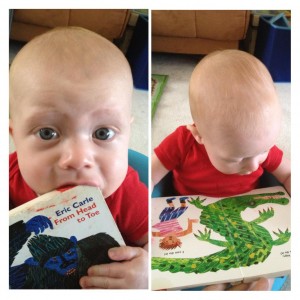
BLACK AND WHITE FLASH CARDS
stimulate your newborn’s brain development. Using high-quality card stock and black-and-white & Baby Yoga- Calming Made Easy Routine– can help soothe fussy babies Bonding Bliss Routine– give your baby love and attention Growing Strong Routine– help your baby learn to stretch, move, roll, sit, crawl.
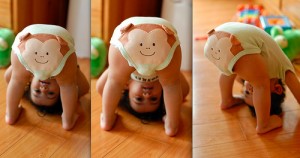
2* Sing Songs/ Read Books/ Flash cards – Learn baby ABCs, 123s and Colors, Shapes, Opposites and Animals- I have Disney First Concepts Books & CD & Mother Goose Books & CD songs like Itsy Bitsy Spider, Wheels on the bus, Working on the railroad, Bingo, Humpty Dumpty, Five little Monkeys- Reading aloud: teaches your baby about communication
introduces concepts such as numbers, letters, colors, and shapes in a fun way
builds listening, memory, and vocabulary skills
gives babies information about the world around them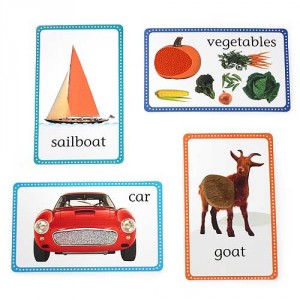
3* Play Sort & Stack Set Game with toys– This game helps develops motor skills by encouraging: 1) Grasping 2) Balance and coordination 3) Exploring with hands 4) Stacking or placing items & Helps baby develop thinking and problem solving skills by learning- shapes, numbers,letters,counting and animals.

4* Nurture Walk- Walking with the baby can be educational too. Yes, I can point out the trees, grass, birds in the sky, plane flying by, green shrubs, dogs barking, cats crossing street, cars driving by and so much more. Singing to the baby will also occupy them on their walk.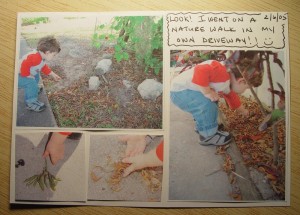
Using Your 5 Senses With Little Kids (Toddler – 5):
Young children will probably be excited with the idea of a nature walk. It provides a good opportunity to talk with them about the changing season, but it is also a pretty good way to start to introduce the idea of the senses. The idea is that you talk about each of the senses as you conduct your nature walk. Little kids probably won’t understand the concept of “senses,” but they can do things like:
What do you hear?
Do you hear the leaf crunching?
What color are the leaves on that tree?
What does the bark feel like?
What does it feel like to crunch the leaf in your hand?
I’m sure you get the idea…
You can have the children collect samples of all the things they “sense” to talk about later and reinforce the concepts. You can also plan some special projects to tie into your nature walk like a leaf rubbing, nature collage, or have them draw a picture of what they “sensed” during the nature walk (you may be surprised at what they come up with on this one).

5* Ball Time– What Babies Learn: A ball is one of the best toys for babies because it’s something to see, touch, and interact with, and it’s the epitome of surprise because it never does the same thing twice. Rolling and, later, throwing and catching a ball help develop hand-eye coordination. Children also enjoy the give-and-take of playing ball with others. “They don’t get tired of playing with a ball because their skills with it continue to grow — even into adulthood.
10:00am – 11:00am
Nap time- rock babies to sleep & sing to them softly

12:00pm
Lunch Time/Clean up dish
12:40pm
1 on 1 time/ story time
1:00pm
1 on 1 Time- the babies play on the floor with toys, books
2:00pm – 3:00pm
Walk or drive to the park

More Games To Play
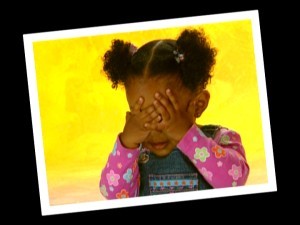
Play Peek a boo– Why it’s so great: Your baby is learning a vital lesson in object permanence. “An infant doesn’t realize that things continue to exist after they’re out of sight.” “She enjoys the surprise element. You disappear and reappear, which is thrilling to her and teaches her that things come back, which will help her deal with separation anxiety later on.”
* How to make it even better: Hold a blanket between the two of you. This adds a lesson in body control — she’ll have to plan to remove the blanket, reach for it, and pull it away.
Patty- Cake – Why it’s so great: “Playing patty-cake is an exercise in rhythm and coordination.” “It also helps your baby develop spatial awareness, as he discovers where to place his hands.” Once your child can sit up on his own, he’ll become more involved in the game, improving his balance and his ability to focus.
* How to make it even better: If you want to work on motor development, teach him to bring his left hand to your left, his right to your right. Learning to cross the invisible line separating left and right is a complex motor skill, one he should be able to master as he approaches his first birthday
3:00pm
SNACK Time
4:00pm

NAP Time
5:00pm – 6:00pm
Dance, Sing songs, ready books, play with toys, draw & color, 1 on 1 time
Talking with Infants:
Babies love to hear language and respond by cooing, babbling and making sounds that gradually resemble adult speech. Throughout the first two years, children are attaching meaning to words and understanding a lot more than they can say. The more attention we pay to children’s speech, the more we can understand, repeat and use words from their own language. I also give them new words to expand their language, thus building a richer, more expressive vocabulary in later years.
Creativity and Play with your children:

1. Listen to your children in order to understand what they are interested in learning more about. Then think of ways to help them explore this interest through the use of creative materials and “family field trips.”
2. Work on giving your children long, uninterrupted periods of play without interfering or getting involved in decision making. If your children ask for your help in solving a problem, think of comments you could make to encourage them to come up with their own solution.
3. Set out different types of blocks and encourage your children to combine them to create a structure of their own design. Give them lots of time to design and build their creation.
4. Challenge your child to look at his playroom or bedroom and think about how to transform the room into an imaginary play space. The room could become a castle, a farm, a jungle, a school or whatever most interests your child. Work with furniture, toys, creative materials and household materials to invent a unique play space.
Games I play on Rainy Days:
Puddle Jumping:
Time
5 to 10 minutes
Materials
Puddles after a rainy day or a lawn watering
Directions
Being told that it is OK to jump in puddles will bring squeals of delight. Go out together dressed in rain gear and stomp in the puddles.
Toddler Bowling:
Materials
Empty plastic soda bottles or unopened paper towel rolls
Large rubber ball
Directions
Line up three or four (or more) empty plastic soda bottles or unopened paper towel rolls.
Show your toddler how to roll a large rubber ball to knock them over.
Flying Fish
Your child will enjoy tossing these fish into the air and watching them gently flutter down.
Materials
Page from an old magazine
Pencil
Ruler
Scissors
Directions
Using the ruler, pencil, and scissors, mark and cut a strip of the magazine page that is as long as the page and 1 inch wide.
Mark a line on each end of the strip that is 1 inch from the end.
Cut a slit halfway into the strip at each point. (At one end of the strip cut from the top halfway down to the middle, and at the other end cut from the bottom halfway up to the middle.)
Bend the strip into a loop and push the slits together so that the loop closes.
Toss the fish into the air to see it fly.
Toddler Duck Duck Goose Game:
Here’s a fun way to play Duck Duck Goose with Toddlers. print out of ducks and a goose and then cut them out and lay them face-down on the floor. Have all the kids stand around in a circle and then tell them all to pick up one off the floor. Go around the room and have each toddler show you what the picture is and say Duck if it is a duck. For the toddler that has the Goose, yell Goose and have all the kids run around a circle. Then have them all put the pieces of paper down and do it again!
Play Tent Extravaganza:
This will surely make your toddlers feel like they are at some fancy amusement park. Invite some other toddlers over and ask each one to bring a play(PopUp) tent. They are easy to pack up and set up. Before guests arrive, make space in a room or outside for plenty of running around. Then when the other toddlers arrive set up all the tents in one room. IT WILL BE CRAZY and your toddlers will think they are in a fun house!! Let them crawl, toddle, and run in and out of the tents. Playing hide and seek is also a favorite with this activity!
Toddler Drum Circle:
Save up a bunch of small containers and boxes for a fun time with your toddlers. Cottage Cheese containers, Oatmeal containers, and small boxes work great for a little toddler drum. Give each toddler a container or box and have them all sit in a circle with the container between their legs. Let them pat the “drums” with their hands or some markers. Try to have them all beat together and count along. Then sing some songs and beat the drums in rhythm. Then let each toddler do a solo and have everyone else listen then applaud!
Disco Party:
Toddlers can have a disco too!! Invite all your toddler friends over and ask them to bring a toy that lights up. Set up one of your rooms so that you can make it dark, either by using curtains or throwing sheets over the windows. Then when all the kids arrive have them all go into the room and put the toys down on the floor and turn them on. Dim the lights and see all the fun lights going off. Some of the toys will probably have their own music, but if not, then play some fun disco music for them and dance around the house.
Have a Camp out:
Invite a few friends and moms over for a fun time camping. Set up your tent in a bedroom and lay sleeping bags and pillows on the floor. Tell your toddler friends to bring their favorite stuffed animal and a flashlight. Turn off the light in the bedroom and let them turn on their flashlights. Give them some books and toys to play with in the tent. While the kids are playing in the tent the moms can sit at the table and enjoy some finger sandwiches.
Have a puppet hunt:
All kids love puppets! Here’s a fun way to introduce the puppets to a group of toddlers. Before the kids arrive, put one puppet to the side (for example, Peter Pan) and hide the rest around the room. When the kids arrive have Peter Pan talk to them and ask them for some help with finding the others. Have Peter Pan tell the kids that he is looking for a friend that has wings and a blue skirt and he last saw her on the couch. Then let the kids look on the couch to find Tinkerbell. Now have Tinkerbell tell the kids that she saw an animal like a crocodile near the plant in the corner of the room. Have the kids find the plant and the crocodile puppet. You can do this until all the puppets are found. During the hunt you can introduce “under, behind, on top, between, etc.”. And you can let the kids review their colors by talking about the colors of the puppets. It’s a fun way to find all the puppets!
Musical Animals:
This is an easier and more suitable (for younger children) version of the familiar musical chairs game.
Materials
1 stuffed animal for each player
1 chair for each player (optional)
Music
Directions
Place several chairs in a circle and put a stuffed animal on each chair, or place the animals in a circle on the floor.
Toddlers walk around the circle and, when the music stops, each player picks up an animal and sits down.
Players then take turns acting out that animal.
If you don’t have enough stuffed animals, paste pictures of various animals on sheets of paper and tape them to the chairs or place them in a circle on the floor.
If only you and your child are playing this game, try placing the stuffed animals inside a pillowcase.
Then take turns removing an animal from the pillowcase and acting it out.
Indoor Baseball:
Games such as this help your toddler develop eye-body coordination and are suitable for indoor as well as outdoor play.
Materials
Empty gift-wrap roll
Balloon
Directions
Play baseball with an inflated balloon and an empty gift-wrap roll.
Take turns hitting, throwing, and running balloon.
Fine motor:
Playdough is such a wonderful tactile activity for toddlers. In the beginning, some may like to try to eat it, and while this is not ideal, a small amount will not harm them. Purchase some cookie cutters, a small rolling pin and add some plastic non-serrated knives and your toddler is set for a whole lot of fun. Some children’s toys stores also sell playdough syringes that you can fill with playdough and squeeze out the other side. This does take a fair amount of muscle power but by 2.5 years your toddler will master it.
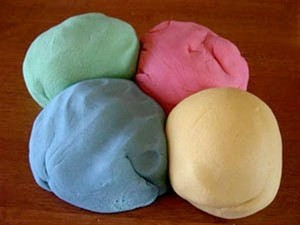
Kool-Aid Playdough
2 1/2 to 3 cups flour
2 cups boiling water with 1 package Kool-aid (any flavor)
3 tablespoons corn oil
1/2 cup salt
1 tablespoon alum
Mix ingredients and knead with flour (may take up to 1 extra cup). Use more if the dough draws moisture in high humidity. Keeps well, has a nice fragrance and is very colorful and very flexible.
Pegs
A great fine motor toddler educational activity! Take a medium square of hard corrugated cardboard (from and old box) and a few wooden pegs. Make sure they are the ones that your toddler can squeeze together on one end so the other opens. Show them how to peg them on and off the edge of the cardboard.
Knob Puzzles
1-year-old toddlers do still battle with the fitting together of the normal puzzles, which is why knob puzzles are ideal for them. The knob forms a little handle that they can hold onto and slide (rather than fit) the shape int the right slot.
Shape containers
Fitting shapes into containers are also a great toddler educational activities. You can elect to make some yourself with old icecream containers and bottle tops or buy ones that have different shapes. You can also save you own vasious bottles and lids for them to srew on and scew off. Be careful with glass containers and perhaps only use glass for older toddlers under direct supervision.
Pegs into holes
We had a wonderful wooden toy when our toddlers were little which was a series of round wooden “pegs” that fitted into a wooden board with the same sized holes. This provided hours of fun for little ones.

Sponges
On a warm day give your toddler a bowl of water with a variety of sponges in it. Show them how to squeeze the water out of the sponge with their fingers. This is one of the easiest fun toddler fine motor activities.
Lacing Shapes
Cut out some basic shapes from thick card, footprints, cat face etc. Punch holes around the edge about 2cm apart. Give your toddler a plastic blunt needle threaded with wool and let them lace the edges fo the cut out.
Puzzles
Puzzles with big pieces are great for your toddler to do. Choose 4, 6 and 8 piece packs that have large pieces. Make sure your toddler can sit comfortable and that your surfaces even. Choose puzzles that are relevant to your toddler’s interests. When these have been mastered choose packs that contain 12, 18 and 24 pieces.
Encourage your toddler to look for the straight edges first. They may be impatient and you need to be patient with them, but finding the straight edge is also a visual discriminatory process which is valuable. Puzzle building should continue through all of your child’s young years as it is a great fine motor activity.

Cutting/Tearing Activities
The following ideas can be used, remember though that your attention span is much longer than a toddlers!
Give your toddler coloured paper to tear or cut with safety scissors in strips.
Give them big clear outlined pictures to cut out
Choose a theme and cut out pictures from magazines together and stick them onto card as a collage
Key game
If you have a handy man in your family ask them if they can make you a series of little doors mounted onto a frame with differing latches and keys for your toddler to open and close. We used to have this activity at a moms and tots group and it was valuable for small wrist movements.
Lids on containers
Save your empty, washed plastic containers and lids. Keep these in a box where your toddler can match lids and containers and learn to screw them on and off.
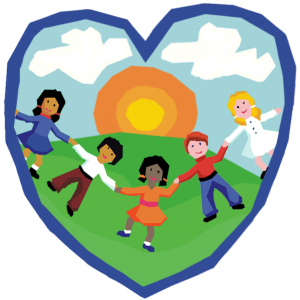
8 Developmental Milestones
| Gross Motor | Mean age | Normal Range |
| In prone head up only | 1 month | 0 to 3 months |
| Head steady at shoulder | 2 months | 1 to 4 months |
| In prone head up to chest | 2 months | 1 to 4 months |
| In prone head up to forearms | 3 months | 2 to 5 months |
| In prone head up with extended arms | 4 months | 3 to 6 months |
| Rolling front to back | 4 months | 3 to 6 months |
| Rolling back to front | 5 months | 4 to 7 months |
| Sitting with support | 5 months | 4 to 7 months |
| Sitting independently | 6 months | 5 to 9 months |
| Creeping on tummy | 7 months | 5 to 10 months |
| Crawling hands and knees | 8 months | 6 to 11 months |
| Pulls to a stand | 9 months | 6 to 12 months |
| Cruises | 11 months | 9 to 14 months |
| Walking | 12 months | 9 to 17 months |
| Running | 15 months | 13 to 20 months |
| Jump on two feet | 24 months | 17 to 34 months |
| Kicks Ball | 24 months | 18 to 30 months |
| Climbs stairs with alternating feet | 30 months | 28 to 36 months |
| Peddles tricycle | 36 months | 30 to 48 months |
| Fine Motor/Adaptive | Mean | Normal Range |
| Unfisted | 3 months | 0 to 4 months |
| Bats at objects | 3 months | 2 to 5 months |
| Objects to midline | 4 months | 3 to 6 months |
| Transfers objects | 5 months | 4 to 7 months |
| Raking grasp | 7 months | 5 to 10 months |
| Finger feeds | 7 months | 5 to 10 months |
| Primitive pincer | 8 months | 6 to 10 months |
| Neat pincer | 9 months | 7 to 10 months |
| Voluntary release | 12 months | 10 to 15 months |
| Helps with dressing | 12 months | 10 to 16 months |
| Spoon feeds | 15 months | 12 to 18 months |
| Uses cup open/sippy | 15 months | 10 to 18 months |
| Imitates housework | 18 months | 14 to 24 months |
| Handedness | 24 months | 18 to 30 months |
| Helps with undressing | 24 months | 22 to 30 months |
| Undresses self | 36 months | 30 to 40 months |
| Toilet training | 24 to 36 months | |
| Social/Emotional | Mean | Normal Range |
| Social smile | 5-6 weeks | 1 to 3 months |
| Object permanence | 9 months | 6 to 12 months |
| Stranger anxiety | 9 months | 6 to 12 months |
| Affective sharing | 10 months | 9 to 18 months |
| Uses mother as secure base | 12 months | 9 to 18 months |
| Separation distress | 12 months | 9 to 24 months |
| Independence | 18 months | 12 to 36 months |
| Parallel play | 24 months | 12 to 30 months |
| Associative play | 30 months | 24 to 48 months |
| Cooperative play | 36 months | 24 to 48 months |
| Language | Mean | Normal Range |
| Cooing | 3 months | 1 to 4 months |
| Laugh | 4 months | 3 to 6 months |
| Turns to voice | 4 months | 3 to 6 months |
| Razzing | 5 months | 4 to 8 months |
| Babbling | 6 months | 5 to 9 months |
| Dada/mama non-specifically | 8 months | 6 to 10 months |
| Gesture games | 9 months | 7 to 12 months |
| Understands no, | 10 months | 9 to 18 months |
| Mama/dada specifically | 10 months | 9 to 14 month |
| One step command with a gesture | 12 months | 10 to 16 months |
| Immature jargoning | 13 months | 10 to 18 months |
| One step command w/out a gesture | 15 months | 12 to 20 months |
| Points to body parts | 18 months | 12 to 24 months |
| Mature jargoning | 18 months | 16 to 24 months |
| Puts two words together | 24 months | 20 to 30 months |
| Pronouns inappropriately | 24 months | 22 to 30 months |
| Two step command | 24 months | 22 to 30 months |
| States first name | 34 months | 30 to 40 months |
| Pronouns appropriately | 36 months | 30 to 42 months |







